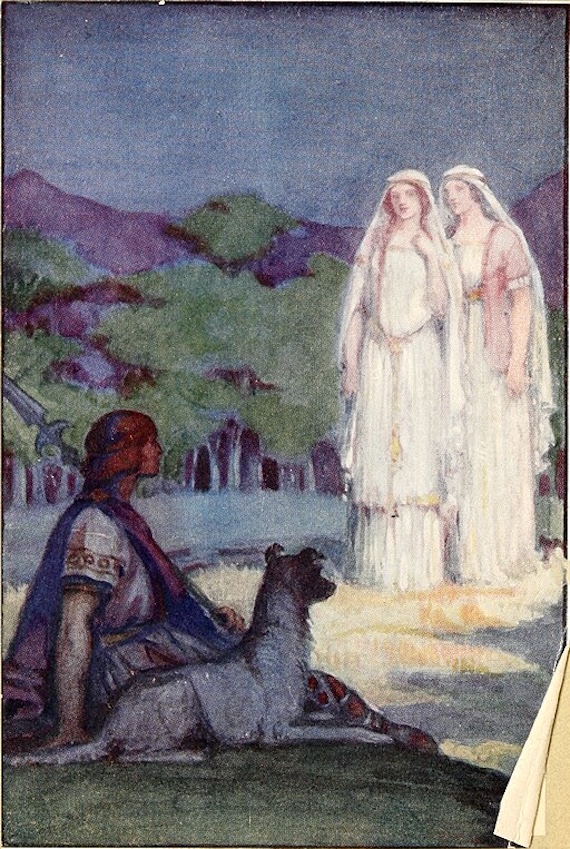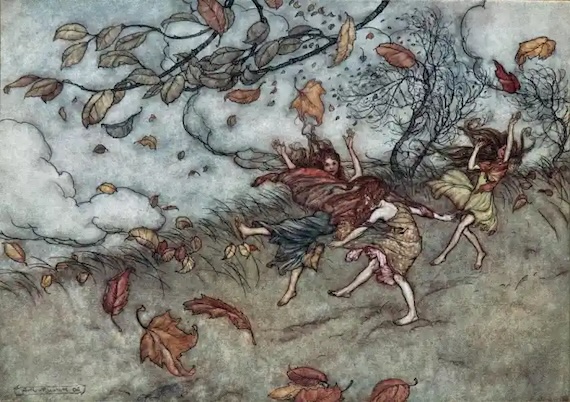Orono, Maine (Special to Informed Comment; Feature) – The Celts, who lived about 3,000 years ago in an area which is now Gaul (France), Ireland, Wales, Scotland, England & Brittany, celebrated their new year during the Lunar calendar, around the 1st week of November, but it is now generally known as the eve of November 1. This day marked the end of summer and the harvest and the beginning of winter, a time associated with the end of the agricultural year and the falling leaves of autumn.
LIMINAL WORLD: On the night before the new year (Samhain), the boundary between the worlds of the living and the dead became blurred. It became a liminal, thin time between the two worlds. It was celebrated as the time when the spirits of the dead appeared, and if crops were not in by this time, they were spoiled by the Aes Sidh (faerie folk) and left for the pookas.
OTHERWORLD SPIRITS: It was believed that otherworld spirits were intertwined with this world, and in times gone by, druid priests and poets would relate stories about the origins of the Celtic people by re-enacting the role of Amairgin, a poet leader of the Milesians, detailing the coming of the 1st settlers to Ireland and Scotland. Stories of the Tuatha De Dannan (people of the goddess Anna) would be recited, as well as the heroic exploits of Cuchullan and Fionn Mac Cuill. Divination and future predictions were given to help villages survive the long winter darkness. The retellings of stories and the playing of music during long winter evenings which provided a comforting pleasure until the coming of Spring (Beltaine, May 1).
BONFIRES: To commemorate Samhain, vast bonfires were prepared, especially at this “fire festival” day, where the people gathered to burn detritus left over from crops and celebrated the end of harvest-time. Offerings were made to agricultural deities. Costumes were worn consisting of straw or animal skins . When the celebrations were over, hearth fires, which had been extinguished earlier in the day, were re-lit from a central bonfire, This act renewed the connectedness of the village people.

Illusration from Heroes of the dawn [Irish mythology]. Violet Russell; Beatrice Elvery, Illustrator. New York: The Macmillan Co. 1914.
ROMANS & ANGLO SAXONS: In the early first millenium Romans had conquered what is now England, Brittany and Wales. As a result many Celtic rituals and ceremonies had been lost or forgotten, especially after the invasion of the Anglo-Saxons from Germany in the 5th century. Ireland and the highlands of Scotland had been saved from the depredation of both the Romans and Saxons, and persevered in keeping alive Celtic rituals and ceremonies.
APPLE: One of these rituals involved the apple, which was revered as an otherworldly food during mythic voyage quests to the isles of the blessed in the western seas. Moder rituals, such as bobbing for apples and carving large turnips with lights inside were adopted from these adventure and voyage stories. In the 20thcentury pumpkins have been substituted for turnips in North America and wearing spectral or ghoulish costumes were intended to ward off demons in this night of the dead. The belief is that a human wearing costumes replicating the dead confused the un-dead who assumed that they were also from the other-world and leave them alone.
THE QUEST WAS A HEROIC JOURNEY: In the Celtic world, the quest for the sacred Apple (Abal or Avalon) islands was a heroic journey. A favorite voyage story was the Voyage of Maelduin where one magic apple provided unlimited nutrition and could feed a crew of 18 for several days. In this voyage, Maelduin was swept out to sea before he could find the murderer of his father on the twin bald islands that he passed between. This magical storm propelled him and his crew along in a spiral journey to 33 islands of the dead. After encountering demon possessed islands and islands of grief and others of raucous laughter, they found an island of peace ruled over by women. After many years that seemed only a brief period in this upside down world at sea, they left and followed a falcon, and eventually found their way back to Ireland but local people of their townland only knew that
Maelduin and his men were of the distant past so they had to cepart but by this time Maelduin had forgiven the killers of his father and did not try to gain revenge.
CELTIC BOOK OF THE DEAD: This metaphoric voyage was referred to by some writers as the “CELTIC BOOK OF THE DEAD”, and was re-enacted in medieval times as an annual pilgrimage. Brendan the Navigator’s famous voyage was a similar quest for a spiritual island paradise, but with a Christian overlay.
IMMORTAL ISLES: These western isles of immortality had several names, including Tir-nan-og, or the “Land of the Ever Young” and Hy Brasil. The isles were thought of as the original home of the Tuatha De Danann (ancient nature deities) which could be reached by traveling west over the sea, or passing through the gateways of the Sidhe mounds. In Tir-nan-Nog, time stood still, while in the mortal world it passed rapidly. The stories of Oisin, Fionn mac Cumhall’s son, and his faerie lover, Niamh, had Oisin three years in the magical realm. He finally returned home to find that three hundred years had passed and he was only a distant memory to the native inhabitants. When he fell from his horse and his feet touched Ireland’s soil, his mortal age returned.
ALL SAINTS DAY: By the 5th century the influence of a tolerant form of Christianity spread throughout Ireland that harmonized with old stories and rituals of the dead. By the 7th century adventurous Celtic hermits and monastics, such as St. Columba of Iona and St Cianaidh (Kenny), settled on islands in the highlands of Scotland and by the 8th century, Pope Gregory III designated November 1 as “All Saints Day”, which incorporated some of the traditions of the Celtic Samhain. All Saints Day was also called All-hallows Eve, meaning All Souls Day) and the night before it, the traditional night of Samhain, in Celtic spiritual tradition, began to be called All-hallows Eve and, eventually, Halloween. Even later, in A.D. 1000, the church would make November 2, All Souls’ Day, a day to honor the dead. It was celebrated similarly to Samhain, with large bonfires, parades and dressing up in costumes as saints, angels and devils.
SAMHAIN=HALLOWEEN: The final month of harvest in the Celtic Year. In times gone by, ancient Celts spent this month preparing for Winter and for the Celtic Feast of Samhain, also known as “Féile na Marbh” (the Feast of the Dead). Samhain (sough-wan) is celebrated at the end of October and beginning of November and is gaelic for summer’s end and winter’s beginning. This ancient festival is a celebration of life over death and a time to remember those who have left the world of the living. Candles are traditionally lit at the graves of ancestors, while bonfires are set ablaze on every hilltop in the countryside. The thin border between the world of the living and the dead becomes transparent on this ‘Ancestors Night’.
Samhain begins the winter season and ends six months later at Beltaine (Baltony) or May-Day. Storytelling and music take place in the evenings at twilight time and legends are recounted by the local Seanachie (Shanachy) in which stories of the great heroes of the past are told: of Lugh, Dagda, Fionn, Cuchullan, Deirdre, Etain and Manannan Mac Lir, etc as well as Adventures and Voyages of the Tuatha De D’annan (people of the goddess Ana or D’ana. There are over 300 such ancient stories and each one takes an evening to tell, so a Seanachie need not repeat the same story during the six months of winter until May-Day (Beltaine). Most villages had their traditional storytellers,
imbued with legendary tales made up in equal measure of courage and sadness, grief and pleasure, suffering and joy.

Arthur Rackham “Autumn Dancing Faeries” (public domain).
Notes on Samhain: (Samhain is pronounced sough-win). The Celts, who lived about 3,000 years ago in an area which is now Gaul (France), Ireland, Wales, Scotland, England & Brittany, celebrated their new year during the Lunar calendar, around the 1st week of November, but it is now generally known as the eve of November 1. This day marked the end of summer and the harvest and the beginning of winter, a time associated with the end of the agricultural year and the falling leaves of autumn.
LIMINAL WORLD: On the night before the new year (Samhain), the boundary between the worlds of the living and the dead became blurred. It became a liminal, thin time between the two worlds. It was celebrated as the time when the spirits of the dead appeared, and if crops were not in by this time, they were spoiled by the Aes Sidh (faerie folk) and left for the pookas.
OTHERWORLD SPIRITS: It was believed that otherworld spirits were intertwined with this world, and in times gone by, druid priests and poets would relate stories about the origins of the Celtic people by re-enacting the role of Amairgin, a poet leader of the Milesians, detailing the coming of the 1st settlers to Ireland and Scotland. Stories of the Tuatha De Dannan (people of the goddess Anna) would be recited, as well as the heroic exploits of Cuchullan and Fionn Mac Cuill. Divination and future predictions were given to help villages survive the long winter darkness. The retellings of stories and the playing of music during long winter evenings which provided a comforting pleasure until the coming of Spring (Beltaine, May 1).
BONFIRES: To commemorate Samhain, vast bonfires were prepared, especially at this “fire festival” day, where the people gathered to burn detritus left over from crops and celebrated the end of harvest-time. Offerings were made to agricultural deities. Costumes were worn consisting of straw or animal skins . When the celebrations were over, hearth fires, which had been extinguished earlier in the day, were re-lit from a central bonfire, This act renewed the connectedness of the village people.
Celtic Mythology, The Triskele or triple spiral The Spirit World of Ancestors and the celestial world of sun, moon, stars and planets. It is considered by many to be among the oldest symbols of spirituality. From its pre-Celtic Origins, the Triskele has been widely adopted in Celtic art and architecture. One of the most notable examples of triskele in art is found at Bruig na Boinne (Newgrange) and is featured at the entrance stone. It can be interpreted as strength, progress, and the intention or motivation to overcome adversity. The flowing knot design represents the Celtic number “three” (which is also sacred in Indo-European numerology) along with lines having no beginning or end.


 © 2025 All Rights Reserved
© 2025 All Rights Reserved